Tui Shou enables us to grasp the notion of fullness and emptiness (yang and yin) through touch. In Tui Shou, fullness is equivalent to great density or concentration, while emptiness corresponds to relaxation or inattention. Training consists in adapting to your partner's touch: if it's full, you react with emptiness, and vice versa. In classical Chinese thought, the concept of emptiness and fullness is found in all the arts (painting, calligraphy, music). Tui Shou also enables us to feel the continual flow of change that always takes place in reality, following the line of least resistance, like water.
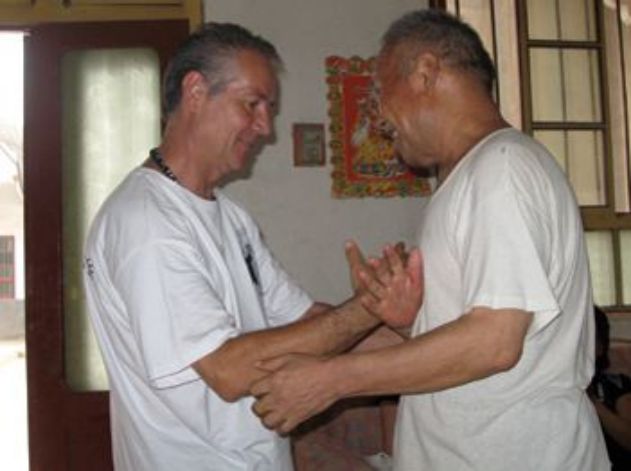
Tui Shou expands our sensory field thanks to elastic movements in all directions (up, down, front, back, circular). The body becomes sensitive and strong, enabling it to react easily. The study of Tui Shou creates the touch for all defense and attack techniques: parries, blocks, strikes. The practice of explosive force enables us to study the transmission of force to our partner. Tui Shou also introduces the principles of imbalance. Tui Shou prepares you for free sparring, as it systematically trains you for the combat phase when you are in contact with your opponent.
Basic exercises are performed by making contact with one hand, on the spot, studying the different directions of force. Push forward, pull, deflect, move up, move down. Then we move on to two-handed exercises, on the spot and on the move. First we study the elastic directions of force, then we learn about imbalances, pushing and pulling the partner. You start by sticking to your partner, then sticking to him as he moves, linking and following all changes of direction.
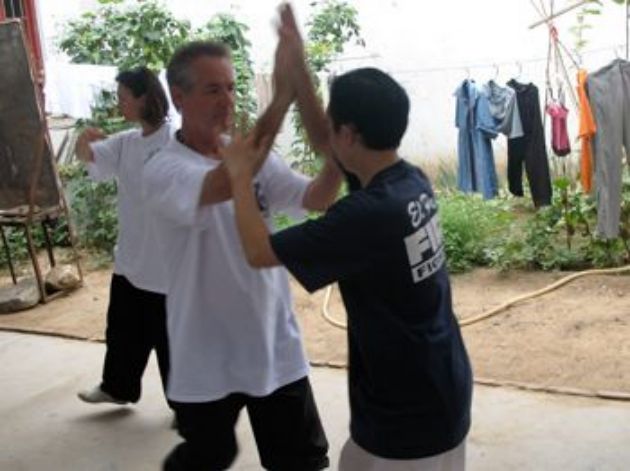
Tui Shou training is one aspect of Chinese martial arts such as Taiji Quan, Xing Yi Quan, Ba Gua Zhang and Wing Chun. Tui shou is closely linked with fundamental notions of Chinese culture. Let's take a look at the specifics of Yi Quan tui shou:
1. Continuity through the spiral
2. Breaking the spiral
3. Transforming and deflecting attacks
4. Power transmission
5. Non-action for better action
1. Continuity through the spiral
The specificity of yi quan tui shou is the two-handed form. The partners' opposite forearms touch, as close as possible to the wrist (see photo1). The forearms rotate like a spiral. Both hands point towards the partner. Both partners perform the same movement alternately. Alternating above, below and around sensitizes the forearm. The gesture is a symbol of yin and yang (perpetual change without rupture or domination). Winding is done with a touch that is neither too empty (soft) nor too full (contracted). We adjust the contact to follow and feel the continuous unfolding of the gesture. Repetition of this gesture unifies sensations between the two partners. This harmonious training allows you to feel and listen to transformations in density and spatial changes with your skin. This gesture is the prelude to rupture (attack initiative). These spiral movements are systematically performed while studying tui shou, on the spot and on the move.

2. Breaking the spiral
Breaking the spiral occurs when one of the two partners wants to attack, push or throw off balance. The breaking phase is achieved by maintaining contact. Hand thrusts enable you to sense changes in rhythm, density (full or empty) and willpower, and to react accordingly. In Yi Quan, attacks can be initiated with one or two hands, with the hands generally aimed at the center of the body. Hand attacks can be transformed into elbow and shoulder strikes. Learning to break the spiral goes hand in hand with learning to transmit power and transform movements. To avoid being thrown off balance, you need to transform and deflect the attack by sticking and following.
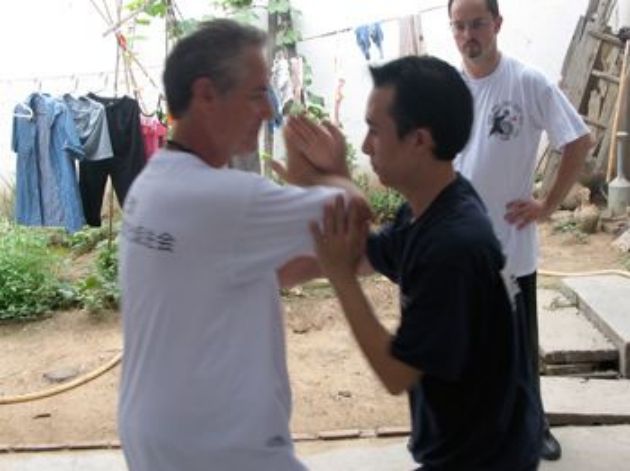
3. Transformation and deflection
There are several ways of avoiding imbalance or attack:
1. Cancellation
2. Deflection
3. Transformation
4. Absorption
1. The ideal (and very difficult) reaction is to cancel the attack initiative as soon as it begins. This is done by changing the density of the contact or the direction of the gesture without breaking. The partner will either follow or be stopped in his tracks.
2. We deviate when we feel too full in a given direction (which will create a vacuum). The deviation depends on the direction of the thrust. For example, on a strong one-handed thrust, you move the rear foot while maintaining arm contact, and let the thrust advance into the void (see photo). Good control of movement techniques makes it easier to deflect thrusts and attacks.
3. The transformation of a thrust is made possible by the elasticity of the body. Maintaining contact during the thrust, changing the direction of the attack (by sticking to it), the partner risks being unbalanced, and will be obliged to follow the change. The transformation can be applied to any type of thrust or attack.
4. The thrust is absorbed when it has not been cancelled, deflected or transformed. Rooting is the basis of absorption. Rooting towards the ground rounds the "arc of the body" and absorbs power by transmitting it to the ground. This absorption allows the bow to return to the opponent. In tui shou, we react to fullness and emptiness. Fullness is synonymous with too much contraction, too much amplitude, too much willpower, etc.... Emptiness is synonymous with too much limpness, lack of presence, lack of rooting, lack of contact.
These techniques were previously studied on their own through "Shili" (trying out strength). Strength is not brute force, but "a force that coils and continues like a silk thread that stretches".
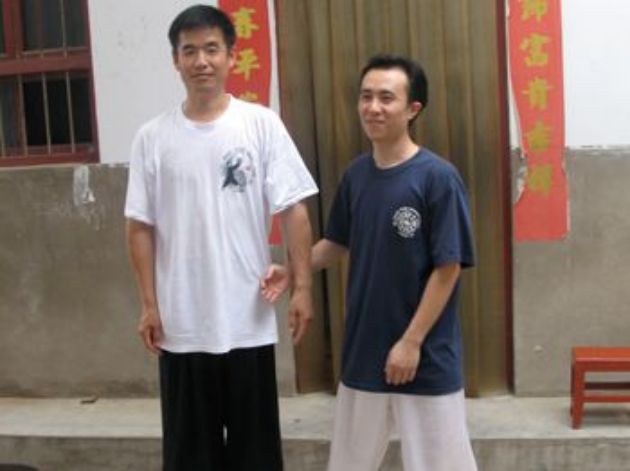
4. Power transmission
The transmission of power to the partner enables :
1. Unbalance
2. Striking
3. Destabilization
Techniques for transmitting force are studied in yi quan through "Fa-li" (gushing force) techniques; in other Chinese martial arts, they are also referred to as "Fa-jing". Before force can burst forth, it must be accumulated (soujing) through Zhang Zhuang and Shili.
1. To unbalance, fali use the body's extension force. Imbalance is achieved either by pushing forward, pulling back, or using the force of opposites (left/right, front/back). The force of the push must be like a spring (brief, ample, explosive). The strength of the body as a whole (zheng ti) is used.
2. To strike, fa-li use the force of percussion, which penetrates a few centimetres. In tui shou, only the body is touched; fa-lis on the body destabilize the partner but do not disable the combat.
3.To destabilize, fali use a multitude of forces: rubbing, pressing, winding, twisting and shaking create a vacuum that can be used to link up a technique to destabilize. The shaking force, for example, is a succession of fa-li like shaking an olive tree. The fa-lis used to destabilize border on imbalance and percussion.
All these forces are created by the sensation of the body's support in space and internal forces (extension, flexion, unification, opposition). The aim of tui shou is not to knock out the partner, but to study the various transmissions of force in contact. Force transmission is essential for parrying and attacking techniques in sanshou (free sparring).
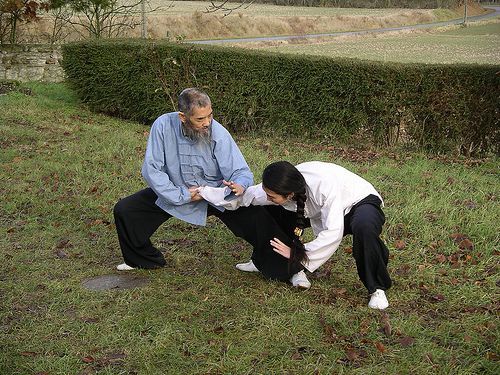
Tuishou are the practical application of the Chinese Taoist notion of non-action (wu wei). The spiral movement and transformation in continuity enable its application. The spiral is a way of sensing the right moment to act. Action is taken without risk, flowing like a flowing river, following the line with the greatest of ease. There is no desire to win or dominate. Non-action implies listening and osmosis with the inner and outer self.
This notion is active. Acting-without-acting is a laissez-faire / laissez-passer. Allowing action to take place on its own. The image of the snake or dragon aptly describes this notion of non-action: "the supple body of the dragon has no fixed form, it undulates and curves in all directions, contracts to unfold, folds to advance; it embraces the clouds so well that, always carried by them, it advances without expending itself".
tuishou
A cultural form of Chinese combat
Tui shou is a form of training for acquiring technical and theoretical principles linked to Chinese culture. This form of combat does not have the same purpose as Western-style fighting. Tui shou is all about feeling harmony, fluidity, elasticity, transformation, explosiveness and rootedness through contact and touch. Control and domination are achieved without brute force.
The tui shou require a long apprenticeship on their own (zhan zhuang for rooting and unity, shi-li for transformation and continuity of forces, fa-li for bursting forth forces, mocabu for movement) before they can be applied in pairs.
Tui shou is the key to achieving the ideal state of body for combat and health. Continuous contact training promotes readiness for the close combat phase of sanshou (free combat).